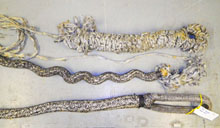A sheet or halyard breakage could result in serious injury or worse, under the immense loads on yachts like 66m (217′) sailing superyacht Aglaia, while racing or even cruising, so it is essential that all running rigging is specified to an immense safety margin. Marine Results has a policy of ensuring a minimum of a 3 to 1 safety rating. The company has just completed an extensive programme of rope break load testing using the running rigging from Aglaia which was tested after a hard season of sailing last year. “The loads on a yacht of this size are testing new frontiers in finding out how rope is going to perform,” explains Ed Danby of Marine Results. “New blends of fibres are being used too, and it is important that we have detailed safe working load data, so Marine Results has taken the lead in an extensive test programme to produce these figures.”
All the running rigging has been put through the tests using Marine Results’ 60 tonne testing machine, which is externally calibrated on an annual basis in accordance with ISO 7500-1:2004 and works using destructive testing to bring the individual products under load. “In a recent study of a superyacht’s genoa sheet, for example, the expected working load was 26 tonnes. We tested the sheet in three different places, the clew eye-splice end, the winch turn sections and the tail (dead) end. The eye splice end broke at 74.5 tonnes, middle section broke at 46 tonnes, and the end section, which never saw any load, broke at 80 tonnes,” says Ed Danby.
Data like this is now available for every aspect of this particular yacht’s running rigging, and Marine Results expect to be able to apply their findings to other sailing superyachts as well.

